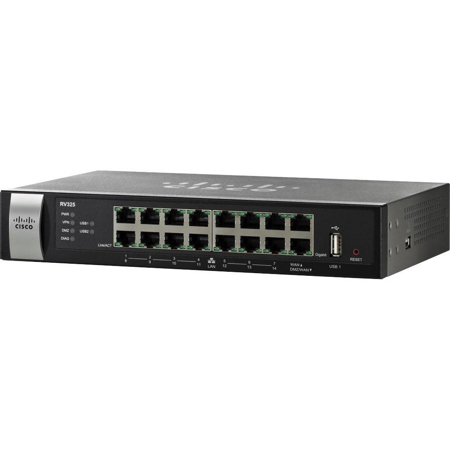
Overview
Compare
Specs
Protection
Q&A
Questions & Answers
Reviews about this item
Review Summary
Cisco RV325 Specifications
Dual WAN
Dual Gigabit Ethernet ports
Failover
Load balancingStandards
802.3, 802.3u
IPv4 (RFC 791)
IPv6 (RFC 2460)WAN Connectivity
Dynamic Host Configuration Protocol (DHCP) server, DHCP client, DHCP relay agent
Static IP
Point-to-Point Protocol over Ethernet (PPPoE)
Point-to-Point Tunneling Protocol (PPTP)
Transparent bridge
DNS relay, Dynamic DNS (DynDNS.org, 3322.org), DNS local database
IPv6Routing Protocols
Routing Information Protocol (RIP) v1 and v2, and RIP for IPv6 (RIPng)
Inter-VLAN routing
Static routing
VLANs supported: 7Network Address Translation (NAT)
Port Address Translation (PAT)
One-to-one NAT
NAT traversalProtocol Binding
Protocols can be bound to a specific WAN port for load-balancing purposes
Network Edge (DMZ)
DMZ port
DMZ hostUSB Ports
Dual USB 2.0 ports (storage and 3G/4G modem support)
Firewall
SPI firewall
Denial-of-Service (DoS) prevention: ping of death, SYN flood, IP spoofing, WinNukeAccess Rules
Schedule-based access rule
Up to 50 entriesPort Forwarding
Up to 30 entries
Port Triggering
Up to 30 entries
Blocking
Java, cookies, ActiveX, HTTP proxy
Content Filtering
Static URL blocking of keyword blocking
Secure Management
HTTPS web access to device manager
Username/password complexity enforcementVLAN
802.1Q VLAN
17 x VLANs supportedWeb Filtering
Content filtering covering 27+ billion URLs
IPsec Access Modes
25 x IPsec site-to-site tunnels for branch office connectivity
25 x IPsec VPN tunnels via Cisco VPN client and third-party clientsSSL VPN Tunnels
10 x SSL VPN tunnels for remote client access
PPTP VPN
10 x PPTP tunnels for remote access
Encryption
Data Encryption Standard (DES)
Triple Data Encryption Standard (3DES)
Advanced Encryption Standard (AES) encryption: AES-128, AES-192, AES-256Authentication
MD5/SHA1
IPsec NAT Traversal
Supported for gateway-to-gateway and client-to-gateway tunnels
VPN Pass-Through
PPTP, Layer 2 Tunneling Protocol (L2TP), IPsec
Advanced VPN
Dead peer detection (DPD)
Split DNS
VPN backup
Internet Key Exchange (IKE) with certificateService-based QoS
Rate control or priority
Rate Control
Upstream/downstream bandwidth per service
Prioritization Types
Application-based priority on WAN port
Priority
Services mapped to one of two priority levels
IPsec VPN Throughput
100 Mbps
SSL VPN Throughput
20 Mbps
Maximum Concurrent Connections
40,000
Web User Interface
Browser-based device manager (HTTP/HTTPS)
Management Protocols
Web browser (HTTP/HTTPS)
Simple Network Management Protocol (SNMP) v1, v2c, and v3
BonjourEvent Logging
Local log
Syslog
Email alert
Short Message Service (SMS)Upgradability
Firmware upgradable through the web browser
Import or export configuration files from or to a USB flash drivePorts
14x 10/100/1000 Gigabit Ethernet RJ-45 ports
1x 10/100/1000 Gigabit Ethernet RJ-45 Internet (WAN) port
1x 10/100/1000 Gigabit Ethernet RJ-45 DMZ/Internet (WAN) portPower Supply
12 V / A
Certifications
FCC Class B, CE Class B, UL, cUL, CB, CCC, BSMI, KC, Anatel
Temperature & Humidity
Operating Temperature: 32 to 104 deg. F (0 to 40 deg. C)
Storage Temperature: 32 to 158 deg. F (0 to 70 deg. C)
Operating Humidity: 10 to 85% non-condensing
Storage Humidity: 5 to 90% non-condensingDimensions
9.6 x 7.0 x 1.8" (243.84 x 177.80 x 45.72mm)
UPC Code
882658842757
About Cisco RV325
Network connectivity is at the heart of every small business and secure access, firewall protection and high performance are the cornerstones of every Cisco Small Business RV Series Router. The Cisco RV325 Dual Gigabit WAN VPN Router is no exception. Featuring intuitive user interfaces, they will have you up and running in mere minutes. These capable router provide reliable, highly secure connectivity for you and your employees and work so well that you won't even know the router is there.
Your business and your employees are exposed to phishing, key loggers, spyware, drive-by malware and other online threats. With these new models with web filtering, you can keep your employees and users safe from unwanted content and malicious websites. This is accomplished without compromising the users' online experience and can even help boost employee productivity and network performance by limiting Internet surfing to appropriate site categories and eliminating unwanted network traffic. Users are also automatically protected from malicious/compromised websites, regardless of site categorization.
In an ever-changing business environment, your small business network has to be powerful, flexible, accessible and highly reliable, especially when growth is a high priority. Your network must also be able to adapt cost- effectively to these growth spurts. The Cisco RV320 and RV325 Dual Gigabit WAN VPN Routers are the choice for any network in which performance, security, reliability and adaptability top the list of requirements. Both support two connections to one service provider, delivering high performance by using load balancing or to two different providers to deliver business continuity.
High-capacity virtual private networks (VPNs) connect multiple offices and enable dozens of employees to access the information they need from any geographic location just as securely as if they were working at your main office.
Cisco RV325 Features
- New models with web filtering to guard against malicious or non-work-related websites
- Dual Gigabit Ethernet WAN ports for load balancing and/or business continuity
- High-performance Gigabit Ethernet ports, enabling large file transfers and multiple users
- Dual USB ports for storage and 3G/4G modem failover
- SSL VPN and site-to-site VPN enable highly secure connectivity, making the Cisco RV320 and RV325 perfect for remote employees and multiple offices
- Strong security: Proven stateful packet inspection (SPI) firewall and hardware encryption
- Easy to set up and use with wizard-based configuration
What's in the box:
- Cisco RV325 Dual Gigabit WAN VPN Router with Web Filtering
- Cisco Lifetime Limited Warranty